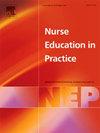Enhancing clinical problem-solving skills in cardiology nursing interns: A randomized controlled study of case-based learning and task-driven learning
IF 3.3
3区 医学
Q1 NURSING
引用次数: 0
Abstract
Aim
To assess the effectiveness of integrating Case-Based Learning (CBL) with Task-Driven Learning (TDL) in the clinical education of nursing interns specializing in cardiology.
Background
Traditional lecture-based learning (LBL) may not adequately prepare nursing interns for clinical problem-solving in cardiovascular specialties. Combining CBL with TDL methodologies could potentially enhance theoretical understanding and practical application skills.
Design
A randomized controlled trial was conducted at Beijing Friendship Hospital, focusing on nursing interns in the cardiology department.
Methods
Nursing interns were randomly assigned to two groups: one group received a combination of Case-Based Learning (CBL) and Task-Driven Learning (TDL) (n = 220), while the other group underwent Lecture-Based Learning (LBL) (n = 218). The study was conducted from June 2021 to March 2024. Evaluation was based on examination scores, nursing round skills and an anonymous questionnaire survey.
Results
The CBL-TDL group engaged in more pre-class preparation and displayed significantly better post-internship theoretical knowledge (92.21 SD 5.73 vs 91.03 SD 4.43, P = 0.016) and ward round skills (means 90.99 SD 7.19 vs 86.62 SD 5.78, P < 0.001) than the LBL group. Higher satisfaction in the CBL-TDL group was noted across several educational aspects (P < 0.01), particularly in motivation to learn (OR 2.50, 95 %CI (1.80–3.45), P = 0.006) and practical skill (OR 2.40, 95 %CI (1.70–3.40), P = 0.002), although they reported less free time consumed.
Conclusions
The synergistic application of CBL and TDL methodologies enhances the theoretical understanding and practical application skills of nursing interns in cardiovascular specialties, suggesting a valuable pedagogical strategy for improving clinical problem-solving abilities.
提高心脏病学护理实习生临床解决问题的能力:基于案例的学习和任务驱动的学习的随机对照研究
目的探讨案例学习(CBL)与任务驱动学习(TDL)相结合在心内科实习护士临床教育中的效果。传统的以讲座为基础的学习(LBL)可能不能充分地为心血管专科的临床问题做好准备。将CBL与TDL方法相结合可以潜在地提高理论理解和实际应用技能。DesignA随机对照试验在北京友谊医院进行,以心内科实习护士为研究对象。方法将实习护士随机分为两组:一组采用案例学习(CBL)和任务驱动学习(TDL)相结合的学习模式( = 220),另一组采用讲座学习(LBL)模式( = 218)。该研究于2021年6月至2024年3月进行。评估基于考试成绩、护理技能和匿名问卷调查。结果CBL-TDL组课前准备较多,实习后理论知识(92.21 SD 5.73 vs 91.03 SD 4.43, P = 0.016)和病房技能(均值90.99 SD 7.19 vs 86.62 SD 5.78, P <; 0.001)均显著优于LBL组。CBL-TDL组在几个教育方面都有较高的满意度(P <; 0.01),特别是在学习动机(OR 2.50, 95 %CI (1.80-3.45), P = 0.006)和实践技能(OR 2.40, 95 %CI (1.70-3.40), P = 0.002),尽管他们报告的空闲时间较少。结论CBL和TDL方法的协同应用提高了心血管专科实习护士的理论理解和实际应用能力,为提高临床问题解决能力提供了一种有价值的教学策略。
本文章由计算机程序翻译,如有差异,请以英文原文为准。
求助全文
约1分钟内获得全文
求助全文
来源期刊

Nurse Education in Practice
NURSING-
CiteScore
5.40
自引率
9.40%
发文量
180
审稿时长
51 days
期刊介绍:
Nurse Education in Practice enables lecturers and practitioners to both share and disseminate evidence that demonstrates the actual practice of education as it is experienced in the realities of their respective work environments. It is supportive of new authors and will be at the forefront in publishing individual and collaborative papers that demonstrate the link between education and practice.
 求助内容:
求助内容: 应助结果提醒方式:
应助结果提醒方式:


